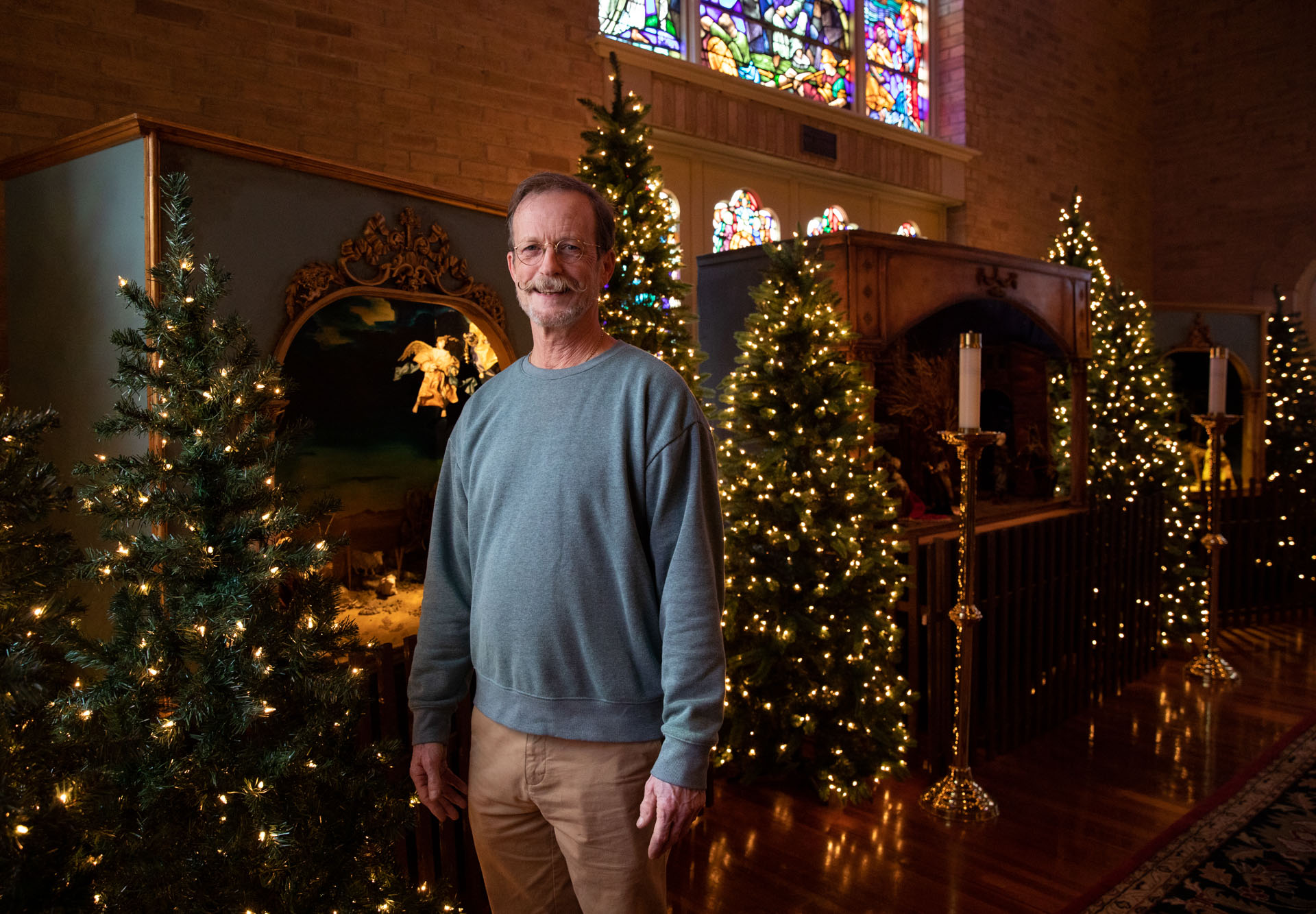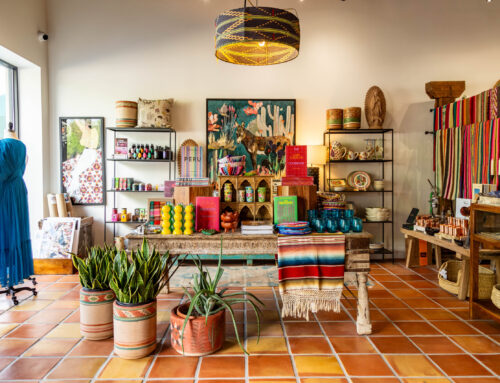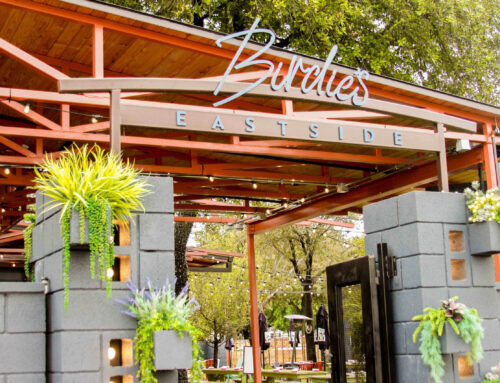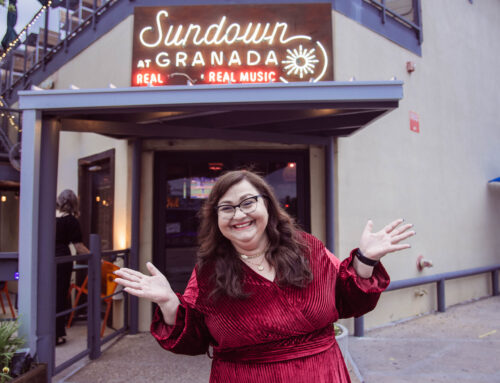
Tommy Bourgeois stands in front of the Christmas crèches at St. Matthew’s Cathedral. Photography by Sylvia Elzafon.
Situated perfectly behind the pews, the three Christmas displays at St. Matthew’s Cathedral seem to have been made for the place.
But appearances deceive.
Junius Heights resident Tommy Bourgeois started the first display, or crèche, in the 1980s, though it wasn’t placed in the historical church on Ross Avenue until years later. Despite their age, Bourgeois hasn’t quite drawn a line under the holiday displays.
“You can always add,” he says.
Bourgeois, originally from New Orleans, came to Dallas for graduate school. He earned a master’s degree in scenery and costume design from Southern Methodist University, back when it was still known as a “league school,” Bourgeois says.
As a graduate, Bourgeois was invited to the league review in New York City. Rather than the novice designers and actors schlepping around the city to find jobs, professional directors, designers and producers went to them.
The review proved fruitful for Bourgeois, who took an offer to work alongside Italian opera designer Beni Montresor, an occupation he held for years. When Montresor moved back to Italy, Bourgeois dabbled in fashion, becoming assistant to the head pattern maker in a sample room for Joseph Abboud.
Though Bourgeois enjoyed the job and was asked to stay at the fashion house to learn even more, his heart was in the performing arts. He left New York, moved permanently to Dallas and occasionally returned to the Big Apple whenever Montresor was in town.
Over the decades, Bourgeois has created displays, sets and costumes for institutions including the Austin Ballet, the Trammell Crow Center and for over 30 years, the Dallas Opera.
“Just about any opera that we do, we build; I put the stuff in their hands, on the stage,” he says. “There’s 30-something years of that in the warehouse — lots of furniture, lots of glasses, lots of plates, lots of stuff.”
One of his most recognizable creations, though, is the 12 Days of Christmas at the Dallas Arboretum and Botanical Garden.
After the success of Dale Chihuly’s glass art display in 2012, arboretum leadership began searching for other potential outdoor exhibits. One board member had the idea of a Victorian 12 days of Christmas exhibit inside the DeGolyer House.
But Bourgeois had a better idea, says Mary Brinegar, the longtime arboretum president and CEO who announced her retirement in October. The exhibit, Bourgeois suggested, should be incorporated into gazebos, with each of the 12 days inspiring each gazebo.
“The idea was to make it as beautiful in the day as it was at night,” Brinegar says.
Having been the associate general director of the Dallas Opera, Brinegar says she knew she could trust in Bourgeois’ work.
Not to mention, his crèche, along with one made by the late Peter Hall, a former costume designer for the Dallas Opera, had previously been on display at the DeGolyer House.
Building the 12 Days of Christmas exhibit took two years. Dallas Stage Scenery helped construct the life-size figures and gazebos.
In part to justify the cost of the exhibit, Brinegar says, her initial idea was to display the gazebos for five years. Nine years later, the exhibit remains.
“We’ve kept it up longer than that because people keep saying, ‘Don’t you dare take it down; this is a tradition for us,’” Brinegar says.
Bourgeois says the project was different from making the Christmas displays now in St. Matthew’s Cathedral, the church he attends. Several people had to believe in his vision for the 12 displays at the arboretum. But when Bourgeois was building the crèche, it was all up to him.
“I ask me what I want,” he says. “And me tells me what they don’t like or do like.”

Christmas display made by Tommy Bourgeois at St. Matthew’s Cathedral. Photography by Sylvia Elzafon.
Though Bourgeois started his first crèche during the Reagan administration, the tradition of creating these nativity displays dates back hundreds of years and was popular in Roman Catholic churches. While building the displays, Bourgeois drew inspiration from his Catholic upbringing and the Christmas tree at the Metropolitan Museum of Art in New York — an 18th century Neapolitan nativity display placed around the tree, which is decorated with silk-robed angels.
Building the crèches is the closest Bourgeois has ever come to designing a window display, the job he wanted as a kid. He’d go to work at the opera, get home late in the evening, work for several hours on the project and then sleep.
The first crèche shows the classic nativity scene — Mary, Joseph, baby Jesus, shepherds with their animals, angels soaring overhead. Bourgeois purchased the animals but made or repurposed almost everything else.
To create each figurine, Bourgeois starts with a wire frame and wooden pieces for shoulders and hips. That’s all wrapped with fabric. The visible parts of the body — hands, feet, chests, heads — are sculpted from clay before Bourgeois bakes them in his home oven.
Then he can work on his favorite part, designing and stitching their clothing. The robes of the flying angels appear to be billowing in the wind, defying gravity rather than hanging lifelessly.
He painted the night sky in the background. Lights illuminate the scene, and pieces of cardboard were cut and painted to make columns, forming an ornate frame around the exterior.
This crèche was originally made for his own home, but it grew too large, so it ended up being displayed in public.
After the first crèche, Bourgeois made one depicting the angels’ annunciation to the shepherds. It has been on display at St. Matthew’s Cathedral for a few years. And debuting this year is a depiction of the Epiphany, the biblical story when wise men called magi saw and honored Jesus.
Bourgeois already has plans to add attendants to the newest crèche for next Christmas.
“These guys can’t be doing this all by themselves,” he says. “And hopefully I can find another camel.”





